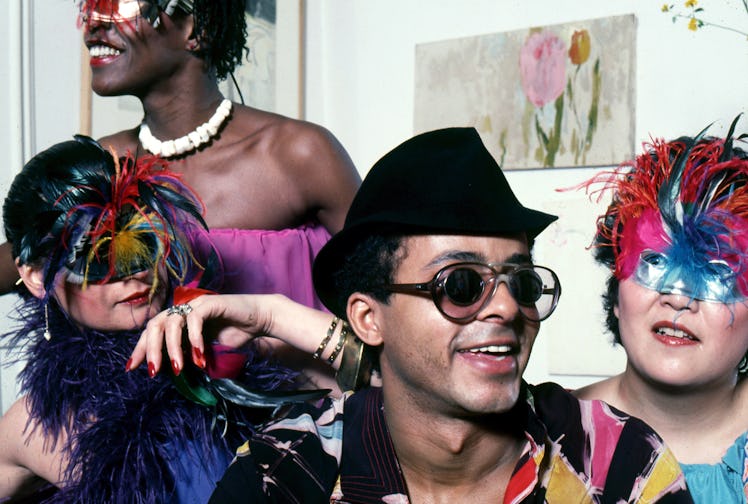Stephen Burrows Looks Back at His Life in Parties
The era-defining designer talks career highlights and fabulous nights out in the 1970s.

“It was a very creative time, and it was a very inclusive time, different from what it had been before,” recalls designer Stephen Burrows of the decade that made him a star, as he created the look of the disco era with rainbow jersey dresses and lettuce-edge hems. By the time he was 30, in 1973, the Newark, New Jersey, native and Fashion Institute of Technology alum had gone from selling homemade club wear from the basement of a Park Avenue boutique to star billing at Henri Bendel. He was the first Black designer to win a Coty Award, and he stole the show as the youngest of the American contingent at the famous Battle of Versailles, outside of Paris. “It was a great accomplishment for a Black guy to have gotten that far at such a young age,” he says. Burrows and his glam-orous entourage, which might have included the model Pat Cleveland, the jewelry designer Elsa Peretti, and Cher on any given night, captured the freedom of the moment with his designs, which showed off the body in a seductive yet elegant way. “My whole aim was to be translucent but not transparent,” he says. “It was a lot of work, but it was fun. Everyone would come to my house and get dressed up. I had to keep making new clothes, because all my friends would take them and I’d never see them again.”
“This was a shoot with Peggy Dillard for Women’s Wear Daily on the East River in 1977, for my return to Bendel’s. It was a really exciting time because it brought me right back to the top after the three years I spent on Seventh Avenue [Burrows had attempted an expansion to department stores with the dress house Ben Shaw], which were a disaster.”
“This is my portrait from Henri Bendel, the best store in New York at the time,” says Burrows of the image below. “I told my teacher when I left FIT: ‘See you at Bendel’s.’ And three years later, I was at Bendel’s. Geraldine Stutz [its legendary president] gave me a boutique on the third floor. I met her through my friend Joel Schumacher [he was the store’s visual display director before heading to Hollywood to become a director], who was the one who discovered me, out on Fire Island. That was the beginning of my career.”
The 1973 charity event Grand Divertissement à Versailles was dubbed the Battle of Versailles, pitting five French designers against five Americans on one star-studded stage. It marked a turning point in fashion, when the Yanks upset the Francs with their freewheeling performances—especially that of Burrows.
“It was just wild: The Parisians’ show went on for an hour and a half; it was too long and too boring. The Americans were new, and we took only 37 minutes to show off what we did. It brought the audience to their feet. They were screaming ‘Bravo!’ and throwing their programs in the air. It put America at the fashion table of global designers. Saint Laurent told me my clothes were beautiful. He saw them and said, ‘Ravissante.’”
A 1973 edition of W Magazine when it was still a broadsheet.
“We were preparing to go out to Studio 54 for the New Year’s Eve party in 1978. Moy [far right] was one of my assistants—she made all the masks that she, Bethann Hardison [second from left], and Daniela Morera are wearing. Oh, it was a great discotheque—they loved artists, and we never had to pay for anything there. I never got in trouble; I just had fun and witnessed a lot of sex going on.” Hardison, a pioneering model turned modeling agent, and Morera, who was then the European editor of Interview, remain Burrows’s close friends.
“Marisa Berenson was one of the special models for Halston at the Battle of Versailles. It was more of a high-society event than a fashion party, so it was all about the socialites who were coming, like Grace Kelly and Gloria Guinness. I was excited to meet them at the dinner they gave after the performance, which was held in Marie Antoinette’s bedrooms. Her bedroom suite was huge—it just went on forever. At some point, the Baron de Rothschild came to introduce me to the ladies. It was my first time in Paris!”
“It was dawn on Fire Island, which was a magical place at the time,” says Burrows (center left). “This is my tribe of friends and the people I worked with in 1972—Roz Rubenstein, my partner in O Boutique [second from right]; my assistant, Hector Torres [second from left]; and a model friend named Daryl Meade [far left]. Charles Tracy was the photographer for our group. There were lots of cliques, where everyone did different things. Everyone had their own DJ, for example. You’d have a plant guy—Halston had a plant guy.”
“This is Ramona Saunders. She had a great body and was one of my top girls. This is in 1968, at O Boutique, a block from Max’s Kansas City, where I got noticed by all the fashion press. We made the clothes in the basement there, and we did a lot of leather pants. It was more a unisex thing—tops and bottoms that anyone could wear. The pants I have on were the first pair I made: I cut up my grandmother’s leather coat and made pants.”
This article was originally published on